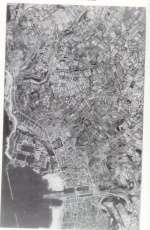

McElfresh Maps are designed to be the definitive topographical portrayal of a given historical event. It's our 20th Anniversary. Click here for more information on anniversary specialsThe map of Gettysburg is an encompassing presentation of the battlefield as it appeared - fences, crops, buildings, terrain - to the Civil War armies as they tramped across the ground. The Le Havre to Cherbourg D-Day map, less detailed but more panoramic, faithfully depicts the beaches, villages, lanes, and hills that confronted the invading Allied forces. The Lewis & Clark and Louisiana Purchase map provides a dramatic overview of the sparse settlement and rudimentory network of roads and trails that characterized a continent still essentially a wilderness. Several of the McElfresh maps (e.g. Santiago de Cuba) represent pioneering research and remain the sole map resource available on their topic.  The reverse side of each map features an in-depth map theme relating to the subject. For example, the reverse of the D-Day map contains text and images of the fabulous "model maps" prepared by U.S. and British intelligence to familiarize the soldiers, sailors, and airmen with the topography they would be confronting. Our vivid display of contemporaneous detail and exhaustive research have made McElfresh maps the guide of choice for the Smithsonian in its Civil War seminars and tours, as well as research tools and illustrations for the nations most acclaimed Civil War authors and historians. These maps are in the collections of libraries from Harvard University to Stanford, and from the Library of Congress (where McElfresh maps hang on the walls of the map reading room) to the Map Library of the British Museum. Cartographer Earl McElfresh is the author of Maps and Mapmakers of the Civil War (Abrams, 1999) a main selection of History Book Club. In addition he has written articles and contributed to other publications. Please click here for a complete list. For a complete portfolio list of original watercolor maps, studies, sketches, etc by Earl McElfresh, please click here.For more information about the maps and how they are created, please follow this link to Earl McElfresh's Blog about the Civil War and mapping. |